
Cumbooquepa is a heritage-listed house at Somerville House, 253 Vulture Street, South Brisbane, City of Brisbane, Queensland, Australia. It was designed by George Henry Male Addison and built in 1890. It is also known as Brisbane High School for Girls. It was added to the Queensland Heritage Register on 21 October 1992.

The Town of Hamilton is a former local government area of Queensland, Australia, located in north-eastern Brisbane.
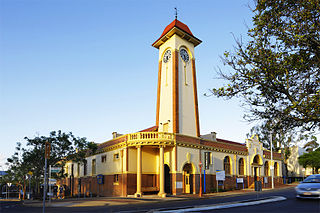
Sandgate Town Hall is a heritage-listed town hall at 5 Brighton Road, Sandgate, City of Brisbane, Queensland, Australia. It was designed by Thomas Ramsay Hall and built from 1911 to 1912 by John Gemmell. It was added to the Queensland Heritage Register on 13 January 1995.

The Shire of Toombul was a local government area of Queensland, Australia, located in northern Brisbane from 1883 to 1925.

The Ithaca Town Council Chambers is a heritage-listed former town hall of the former local government area of the Town of Ithaca, and now a community centre in Paddington, City of Brisbane, Queensland, Australia. Located at 99 Enoggera Terrace, Red Hill, it was designed by Atkinson and McLay and built in 1910 by Charles Thomas Hall and Francis Joseph Mayer. It is also known as Ithaca Library and Red Hill Kindergarten. It was added to the Queensland Heritage Register on 24 March 2000.

Mackay Town Hall is a heritage-listed former town hall at 63 Sydney Street, Mackay, Mackay Region, Queensland, Australia. It is the second town hall to be built on this site. It was designed by Arthur Rigby built in 1912 by Charles Porter for the Mackay Town Council. It was added to the Queensland Heritage Register on 29 May 1998.

Soldiers Memorial Hall is a heritage-listed memorial at 149 Herries Street, Toowoomba City, Queensland, Australia. It was designed by Hodgen & Hodgen (Toowoomba) and built from 1923 to 1959 by Smith Bros (Toowoomba). It was added to the Queensland Heritage Register on 17 December 1999.
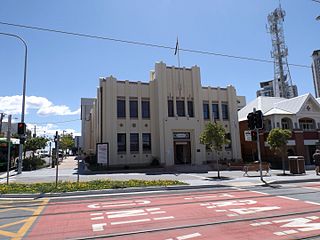
Southport Town Hall is a heritage-listed former town hall at Nerang Street, Southport, Gold Coast City, Queensland, Australia. It was designed by Hall & Phillips and built in 1935 by H Cheetham. It is also known as Gold Coast City Hall, Gold Coast Town Hall, and South Coast Town Hall. It was added to the Queensland Heritage Register on 5 October 1998.

Musket Villa is a heritage-listed detached house at 251 Lancaster Road, Ascot, Queensland, Australia. It was designed by architectural firm Hall and Prentice and was built in 1923. It is also known as Lancaster Gables. It was added to the Queensland Heritage Register on 28 July 2000.

South Brisbane Library is a heritage-listed former library at 472 Stanley Street, South Brisbane, City of Brisbane, Queensland, Australia. It was designed by Francis Drummond Greville Stanley and built from 1881 to 1902 by W Macfarlane. It is also known as South Brisbane School of Arts, South Brisbane Mechanics Institute, South Brisbane Technical College, and South Brisbane Post & Telegraph Office. It was added to the Queensland Heritage Register on 21 October 1992. It now houses the Griffith University Film School, which forms part of the Queensland College of Art.

Coorparoo School of Arts and RSL Memorial Hall is a heritage-listed school of arts at 208 Cavendish Road, Coorparoo, City of Brisbane, Queensland, Australia. It was built from 1892 to 1953. It is also known as Coorparoo School of Arts and Coorparoo Shire Hall. It was added to the Queensland Heritage Register on 6 January 1999.
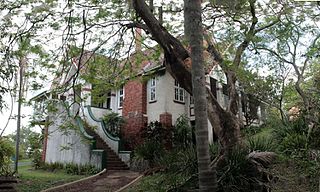
Kurrowah is a heritage-listed mansion at 218 Gladstone Road, Dutton Park, City of Brisbane, Queensland, Australia. It was designed by Lange Leopold Powell and built from 1915 to 1916. It was added to the Queensland Heritage Register on 13 June 2014.
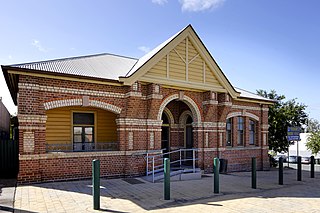
Toombul Shire Hall is a heritage-listed town hall at 1141 Sandgate Road, Nundah, City of Brisbane, Queensland, Australia. It was designed by John Hall & Son and built from 1891 to 1891. It is also known as Toombul Divisional Board Offices. It was added to the Queensland Heritage Register on 21 October 1992.
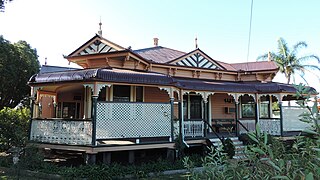
Aberfoyle is a heritage-listed detached house at 35 Wood Street, Warwick, Southern Downs Region, Queensland, Australia. It was designed by architect Hugh Hamilton Campbell and built from 1910 to c. 1927. It was added to the Queensland Heritage Register on 5 August 1996. It is also listed on the Southern Downs Local Heritage Register.

Gladstone Regional Art Gallery and Museum is a heritage-listed former town hall and now art gallery and museum at 144 Goondoon Street, Gladstone, Gladstone Region, Queensland, Australia. It was designed by Roy Chipps and built from 1933 to 1934 by relief workers. It is also known as Gladstone Town Hall & Council Chambers. It was added to the Queensland Heritage Register on 7 July 1998.
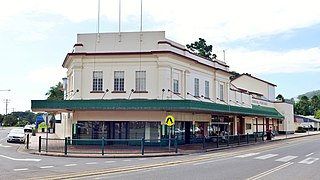
Mossman Shire Hall and Douglas Shire Council Chambers is a heritage-listed former town hall at 8-14 Mill Street, Mossman, Shire of Douglas, Queensland, Australia. It was designed by Hill & Taylor and built in 1937 by Tarmey & Euhus. It was added to the Queensland Heritage Register on 6 August 2010.

Gayndah Shire Hall is a heritage-listed town hall at 32-34 Capper Street, Gayndah, North Burnett Region, Queensland, Australia. It was designed by Hall & Phillips and built from 1934 to 1935. It is also known as Gayndah Soldiers' Memorial Hall, Gayndah Town Hall, and Gayndah and District Soldiers Memorial Hall and Council Chambers. It was added to the Queensland Heritage Register on 28 September 2001.
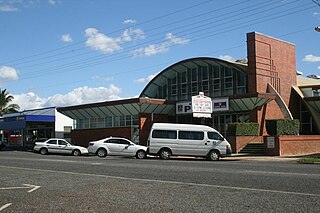
Mareeba Shire Hall is a heritage-listed former town hall at 136 Walsh Street, Mareeba, Shire of Mareeba, Queensland, Australia. It was designed by Eddie Oribin and built from 1960 to 1961 by Ernest William Lepinath. It is also known as Former Mareeba Shire Hall. It was added to the Queensland Heritage Register on 11 October 2013.

Murgon Civic Centre is a heritage-listed town hall at 62-70 Lamb Street, Murgon, South Burnett Region, Queensland, Australia. It is also known as Murgon Public Hall. It was designed by Clifford Ernest Plant and built in 1938 by HG Neilsen. It was added to the Queensland Heritage Register on 9 November 2012.

Hamilton State School is a heritage-listed state school at Oxford Street, Hamilton, City of Brisbane, Queensland, Australia. It was built in 1907. It was added to the Queensland Heritage Register on 30 November 2018.

























